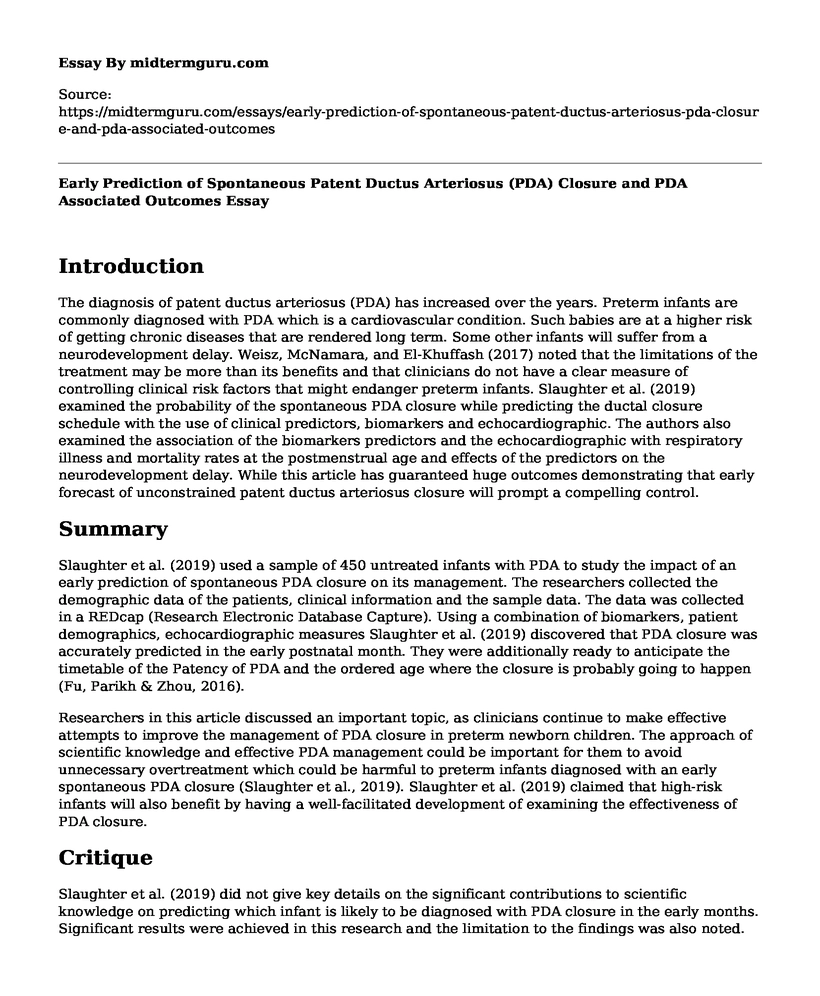Introduction
The diagnosis of patent ductus arteriosus (PDA) has increased over the years. Preterm infants are commonly diagnosed with PDA which is a cardiovascular condition. Such babies are at a higher risk of getting chronic diseases that are rendered long term. Some other infants will suffer from a neurodevelopment delay. Weisz, McNamara, and El-Khuffash (2017) noted that the limitations of the treatment may be more than its benefits and that clinicians do not have a clear measure of controlling clinical risk factors that might endanger preterm infants. Slaughter et al. (2019) examined the probability of the spontaneous PDA closure while predicting the ductal closure schedule with the use of clinical predictors, biomarkers and echocardiographic. The authors also examined the association of the biomarkers predictors and the echocardiographic with respiratory illness and mortality rates at the postmenstrual age and effects of the predictors on the neurodevelopment delay. While this article has guaranteed huge outcomes demonstrating that early forecast of unconstrained patent ductus arteriosus closure will prompt a compelling control.
Summary
Slaughter et al. (2019) used a sample of 450 untreated infants with PDA to study the impact of an early prediction of spontaneous PDA closure on its management. The researchers collected the demographic data of the patients, clinical information and the sample data. The data was collected in a REDcap (Research Electronic Database Capture). Using a combination of biomarkers, patient demographics, echocardiographic measures Slaughter et al. (2019) discovered that PDA closure was accurately predicted in the early postnatal month. They were additionally ready to anticipate the timetable of the Patency of PDA and the ordered age where the closure is probably going to happen (Fu, Parikh & Zhou, 2016).
Researchers in this article discussed an important topic, as clinicians continue to make effective attempts to improve the management of PDA closure in preterm newborn children. The approach of scientific knowledge and effective PDA management could be important for them to avoid unnecessary overtreatment which could be harmful to preterm infants diagnosed with an early spontaneous PDA closure (Slaughter et al., 2019). Slaughter et al. (2019) claimed that high-risk infants will also benefit by having a well-facilitated development of examining the effectiveness of PDA closure.
Critique
Slaughter et al. (2019) did not give key details on the significant contributions to scientific knowledge on predicting which infant is likely to be diagnosed with PDA closure in the early months. Significant results were achieved in this research and the limitation to the findings was also noted. First, the size of the sample was small. Only 10-20% of the preterm infants were subjected to perform a standardized exam. With this kind of a small population sample, it is very difficult to give a general conclusion on these findings to a larger preterm infant population.
Secondly, the participants in this study were from the Ohio State University Center for Clinical and Translational Science. This became a limit to the generalization of the findings to a larger infant population. Slaughter et al. (2019) stated that the research should be done on a larger population and other health institutions, but the authors of this article did not highlight how these could be a limitation to their study.
This article examined an important topic within infant health, as clinicians need to formulate solutions to improve the management PDA closure in newborn children to maintain a strategic distance from overtreatment. One of the barriers clinicians face is the lack of knowledge on how to detect the PDA closure among early infants. The outcomes of PDA closure is important management which will include nursing assessment such as circulation, nursing diagnosis including activity intolerance, nursing care planning and goals such as maintaining adequate cardiac output, and nursing interventions such as postoperative procedures. This article provides important information regarding pathophysiology of PDA which will enable them to assess, plan, and implement patient-centered care.
Conclusion
Slaughter et al. (2019) provided encouraging outcomes of a scientific knowledge and effective PDA closure management designed to help clinicians to be able to predict PDA closure and patency in infants. The future researchers will not be able to use this program in other samples because this study did not describe the effective PDA management adequately. The generalization of findings became limited due to the use of a small sample of the preterm infant population. Future study on early forecast of unconstrained PDA closure and PDA-related results with clear format of the condition within a larger and diverse population is important to provide more evidence of the impact on infants.
References
Fu, Z., Parikh, C., & Zhou, B. (2016). Penalized variable selection in competing risks regression. Lifetime Data Analysis, 23(3), 353-376. doi: 10.1007/s10985-016-9362-3
Slaughter, J., Cua, C., Notestine, J., Rivera, B., Marzec, L., & Hade, E. et al. (2019). Early prediction of spontaneous Patent Ductus Arteriosus (PDA) closure and PDA-associated outcomes: a prospective cohort investigation. BMC Pediatrics, 19(1). doi: 10.1186/s12887-019-1708-z
Weisz, D., McNamara, P., & El-Khuffash, A. (2017). Cardiac biomarkers and haemodynamically significant patent ductus arteriosus in preterm infants. Early Human Development, 105, 41-47. doi: 10.1016/j.earlhumdev.2016.12.007
Cite this page
Early Prediction of Spontaneous Patent Ductus Arteriosus (PDA) Closure and PDA Associated Outcomes. (2022, Sep 12). Retrieved from https://midtermguru.com/essays/early-prediction-of-spontaneous-patent-ductus-arteriosus-pda-closure-and-pda-associated-outcomes
If you are the original author of this essay and no longer wish to have it published on the midtermguru.com website, please click below to request its removal:
- Reduction of Obesity - Paper Example
- Archetype of the Mother Figure in Literature - Essay Sample
- Essay Sample on Breast Cancer and Prostate Cancer Disorders
- Wellness: An Occupied Incorporation of Physical, Mental & Spiritual Welfare - Essay Sample
- Smile Matters: Dental Appearance and Physical Perception - Essay Sample
- SDLC: Integrating Technology in Health Care for the Future - Essay Sample
- Living a Healthy Lifestyle: A Necessity for a Healthy Life - Essay Sample







